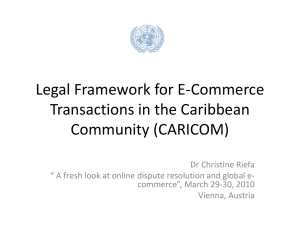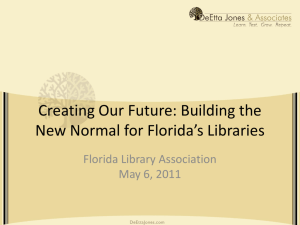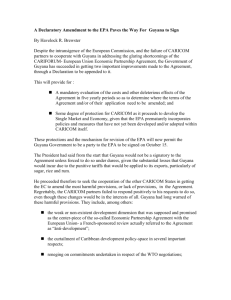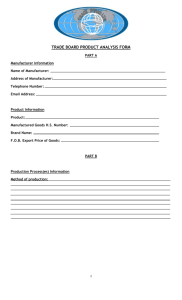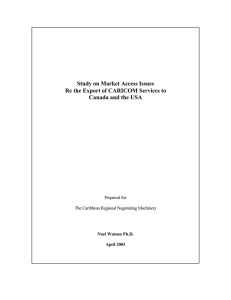Infrastructure imperatives and integration in the transport
advertisement
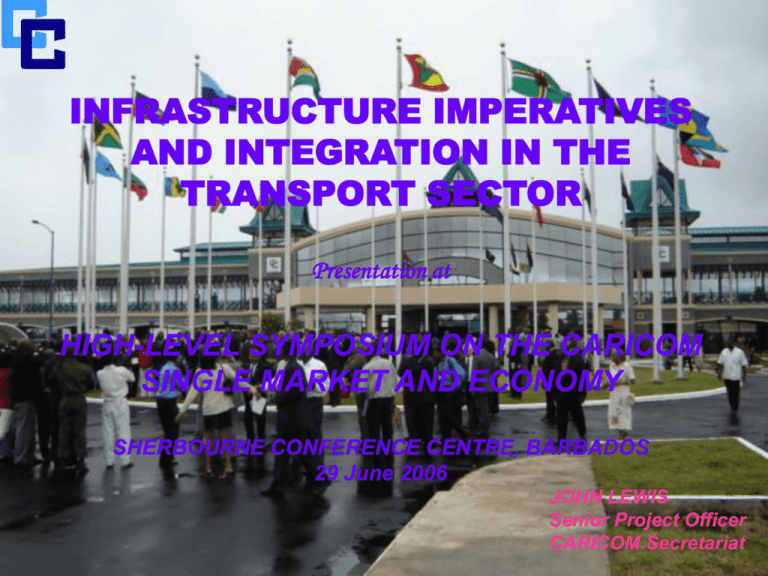
INFRASTRUCTURE IMPERATIVES AND INTEGRATION IN THE TRANSPORT SECTOR Presentation at HIGH-LEVEL SYMPOSIUM ON THE CARICOM SINGLE MARKET AND ECONOMY SHERBOURNE CONFERENCE CENTRE, BARBADOS 29 June 2006 JOHN LEWIS Senior Project Officer CARICOM Secretariat OUTLINE •Importance of transport infrastructure •Considerations for infrastructure development •Challenges •Enabling environment (Treaty, Air Services Agreements) •Imperatives IMPORTANCE OF INFRASTRUCTURE • Provides necessary linkages between sources of raw materials > manufacturing/processing centers > markets • Vital for Community trade, access to tourism markets, social integration of peoples of Community (NO INFRASTRUCTURE, NO TRADE, NO INTEGRATION) IMPORTANCE OF INFRASTRUCTURE Cont’d Need to cope with increasing level of traffic: PAX: • Tourist arrivals up 8.3%: 4.8m in ’95, 5.2m in ‘04 • Bahamas, Jamaica, Barbados and Trinidad and Tobago major destinations (28, 26, 11, 9%, respectively) • US and Europe principal sources (62 and 18%) • Cruise ship arrivals show dramatic increase; up 110% from 3.7m in ’95 to 7.8m in 04 • LA/Car accounted for 4.5% of world scheduled pax traffic in 2002 IMPORTANCE OF INFRASTRUCTURE Cont’d CARGO (Tonnes): •Imports up 20%: 20m in ‘00, 24m in ‘03 •Principal sources: CC, US, LA Integ Assoc. •D-Exports 30m in ‘00, 50% > imports •Principal destns: US, CC, Europe in 2003 •LA/Car accounted for 3.3% of world sched freight and mail traffic in 2002 (Regional traffic not critical for global carriers which serve the region) IMPORTANCE OF INFRASTRUCTURE Cont’d •changing pattern and growth of traffic have implications for infrastructure development and logistics in terms of handling capacity, route development, frequency of services and transhipment •impact level of charges for freight, handling, storage and related services and hence the competitiveness of the region’s imports and exports IMPORTANCE OF INFRASTRUCTURE Cont’d •Land transport plays a minor role in the integration process - no “Euro-tunnels”, int’l rail or trucking services •Air and maritime transport major modes •Inadequate transport infrastructure impacts negatively on integration process, ability to expand or diversify trade, competitiveness of firms and integration in global economy CONSIDERATIONS FOR INFRA DVLPMENT • Relatively small size and spatial distribution of populations of Community as well as the physical geography of Member States • CARICOM - 14.8 m • Mercosur and CACM - 190 and 38 m, resp • ASEAN - 500 m • CMESA and ECWAS - 119 and 252 m, resp • Haiti - 8.4 m, other Member States range between 5,000 and 2.6 m •Strategic geographical location of some CARICOM ports offers significant economic opportunities as transhipment hubs. The Bahamas, Barbados, Jamaica and Trinidad and Tobago are cases in point •Belize and Guyana offer neighbours overland access to the sea, and provide the Community with alternative gateways for trade with Central and South America partners CHALLENGES •Geographical spread and the operational limitations at ports present logistical challenges in establishing a comprehensive, seamless transport system in the Community •Smaller States depend on a complementary network of small vessel or commuter aircraft operations to link them to their principal markets via regional hubs CHALLENGES Cont’d •Low density, cyclical nature and directional flow of cargo and passenger traffic which impact on overall “load factor” or capacity utilisation ratio of carriers, hence their viability •DOM, SVD, BAR, GUY investing significantly in airport development to increase capacity and air access •JAM investing significantly (US$200m 5th phase project) in port development to increase capacity to handle TEU containers and transhipment CHALLENGES Cont’d •Developing capacity, new route structures (transCaribbean, Southern African) and promoting commercial arrangements with transport operators to enable more direct access to markets •Need to reduce dependence on transit through United States and European gateways •Recognise that US and European gateways will continue to be attractive due to high traffic volumes that impact cost, convenience of onward connections and the high cost of route development CHALLENGES Cont’d •There are new imperatives resulting from security, economic, political and social considerations •Package of incentives, appropriate equipment and a capacity to absorb the high initial financial costs, present an opportunity to promote niche operations involving both private and government sector partnership as a means of developing nontraditional routes for the long-term overall benefit to regional integration. ENABLING ENVIRONMENT Revised Treaty: • Framework for development of the transportation sector of the Community • Provides for coordination of national transport policies (Art. 135); and Most Favoured Nation treatment to be accorded to Member States (Article 8) • Prohibits introduction of new restrictions relating to the right of establishment, the provision of services and the movement of capital • Requires removal of existing restrictions (Chapter 3); ENABLING ENVIRONMENT Cont’d Revised Treaty: • makes specific provisions for the development of the transportation sector generally, including: – conclusion of air transport agreements among Member States – establishment of joint ventures – investment in the sector – joint action – cooperation among the air transport operators of Member States in areas as interline and inter-modal operations, code sharing, reservations, insurance and leasing; and – development of ancillary services, including freight forwarding and transshipment ENABLING ENVIRONMENT Cont’d Air Services Agreements: • Within the scope of the Revised Treaty (Art. 80) and must be consistent with its provisions • Complex series of agreements, MOUs and informal arrangements provides the basis for conduct of international air transport • Joint consultations initiated with UK early 1990’s. (Consultations suspended) • Joint consultations initiated with the US in August 2004 also suspended. Efforts being made to resume ENABLING ENVIRONMENT Cont’d ACS Multilateral Air Agreement: • Opened for signature in Feb 2004. Signed by certain CC and other ACS States • Enters into force 60 days after receipt of ninth Instrument • Provides opportunities for the development of non-traditional, trans-Caribbean routes and closer economic and social relations between CARICOM and other ACS States ENABLING ENVIRONMENT Cont’d CC Multilateral Air Agreement: • Promotes the objectives of the Community and provides the required framework for CARICOM air carrier to provide air services between the Member States • Entered into force in Nov 1998, presently in force among nine Member States • Provides a role for niche operators on low density routes, greater flexibility than previously obtained in aircraft routing and flight scheduling by the established carriers • Needs to be revised IMPERATIVES • Continuing investment in regional transport infrastructure to enable the Community to keep apace with developments in containerised shipping, aircraft operations and the new technologies and logistics systems that enhance the efficiency of air and sea port operations • Development of an incentive programme for transport enterprises aimed at promoting the development of non traditional routes within and across the Caribbean basin IMPERATIVES Cont’d •Development of intra-regional shipping services by small vessel operators to support the regional thrust of agricultural diversification •Conclusion of liberal air services agreements with major trading partners to facilitate market access, the delivery of more integrated multimodal transport services to travellers, importers and exporters •Development of intra-regional shipping services by small vessel operators to support the regional thrust of agricultural diversification IMPERATIVES Cont’d •Conclusion of liberal air services agreements with major trading partners to facilitate market access, airlift and the delivery of more integrated multimodal transport services to travellers, importers and exporters •Exploitation of the opportunities provided in the ACS Multilateral Air Agreement for multidestination tourism, trans-Caribbean route development •Continuing support for the rationalisation and capitalisation of regional air carriers to ensure their their sustained operation based on an agreed programme for improved efficiency and profitability Our regional transport infrastructure is critical for the development of regional economies and achieving our integration objectives and should perhaps be given special treatment and provided with the necessary resources to ensure its development and maintenance. Thank You
